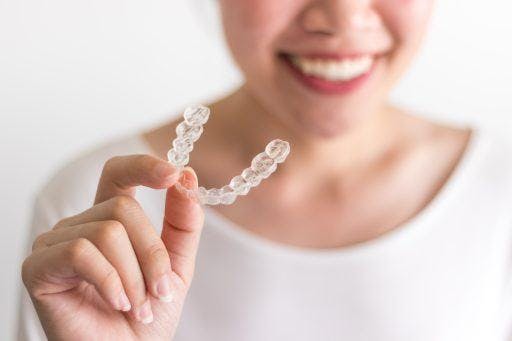An overbite is a common problem not just in Australia but around the world. In fact, according to a global study by the Dental Press Journal of Orthodontics, around 22% of people have a deep overbite. Ignoring the issue can lead to health complications in the long run. So, it’s wise to pay close attention to your malocclusion. Learn about the factors that may worsen your alignment and explore treatment options to help you smile more confidently.
What is an overbite?
An overbite is a form of malocclusion where the upper front teeth protrude beyond the lower teeth. Small overbites are necessary for a proper bite, but they should still close and fall just above the bottom teeth. An overlap of over two to three millimetres is excessive and requires treatment.
Types of overbites
Two types of overbites determine the kind of treatment your orthodontist will prescribe.
- Dental overbites: These result from external habits formed during dental development in children. The repetitive nature of certain practices causes overbites or worsens preexisting conditions.
- Skeletal overbites: These result from irregular jawbone development, which can prompt the top teeth to protrude. Consequently, the teeth can shift and fill the mouth incorrectly. For many, skeletal overbites are genetic.
Overbite versus overjet

To the untrained eye, an overbite and overjet appear the same. It’s easy to see why, as both conditions involve the upper front teeth, and both have unfortunately been bestowed with the moniker “buck teeth.”
An overbite means your upper front teeth are low enough to cover most of your bottom teeth. On the other hand, when you have an overjet, your upper front teeth protrude forward, creating a space between the two rows. In many cases, you can have both an overbite and an overjet.
What causes overbites to worsen?

Besides your genetic makeup, several other factors can exacerbate your overbite.
1. Thumb-sucking
Infants have natural sucking and rooting reflexes, which cause them to put their thumbs or fingers into their mouths. The habit provides babies with a sense of security and helps them to self-soothe or fall asleep.
Most toddlers grow out of sucking their thumbs, but others take the mannerism into adulthood as a stress-coping mechanism. However, according to the Australian Society of Orthodontists, prolonged thumb-sucking can lead to a “distinct overbite or an overjet of the front teeth” from the pressure on developing teeth.
2. Tongue thrusting
Tongue thrusting is an oral condition where your tongue protrudes towards the front or side of the mouth. This habit can occur when a person speaks, swallows, or when the tongue is at rest.
According to a Journal of Dental Research, Dental Clinics, Dental Prospects study, people who exhibited tongue thrusting had a higher occurrence of misalignment. The constant pressure of the muscle against the teeth can result in protrusion.
3. Nail-biting
Frequent biting of fingernails and other hard items can pull your teeth to the front. It can also cause them to shift and become misaligned from the pressure, leading to the formation of an overbite. This misalignment not only affects the appearance of your smile but also leaves you at risk of dental health problems.
4. Poor diet and oral hygiene
According to a British Journal on Nutrition study, a correlation exists between poor diet and oral health problems, including tooth loss. The research found that people who consumed low amounts of fruits and vegetables were more likely to experience missing teeth. This can then progress into gaps that affect alignment.
Leaving these spaces in your mouth can cause the remaining teeth to shift, potentially leading to an overbite. You can prevent the issue with a nutritious diet and excellent oral hygiene, especially by brushing, flossing, and visiting your dentist regularly.
5. Sleeping on your stomach
Research on infant development by the Journal of Anatomy stresses how babies who sleep on their stomachs are at risk of developing an overbite. The position places the infant’s growing jawbones under pressure, causing them to narrow and limiting the room for secondary (permanent) teeth. The absence of space results in crowding and malocclusions. Although the risk of developing an overbite among belly-sleeping adults is low, it’s never zero.
Why should you correct overbite teeth?
Having an overbite means your teeth are more prone to wear and tear, which could lead to many other dental issues, such as staining and cavities. When left untreated, overbite teeth can lead to the following issues and complications:
- Tooth decay
- Jaw pain
- Headaches
- Gum disease
- Temporomandibular joint (TMJ) disorder
- Problems fully opening or closing the mouth
- Discomfort while eating
- Difficulty speaking
- Sleep apnea
Additionally, an overbite can result in dramatic changes in facial structure – especially when coupled with an overjet. Buck teeth in early childhood can continue to worsen and become the underlying cause of low self-esteem from prepubescence to adulthood.
How to correct an overbite?

The type of treatment for misaligned teeth depends on your age and the severity. Generally, orthodontists recommend the correction of malocclusions as early as age seven. Prompt management of an overbite helps reduce the knock-on effect of other oral problems when growing. It might be a bit harder to fix an overbite as an adult, but it’s still possible. Have a look at the different options available:
Metal braces
Braces carefully apply pressure to adjust and align teeth correctly. Orthodontic treatment using braces works best on dental and not skeletal overbites. The duration of treatment can last from 18 months to several years, depending on severity.
Cervical pull headgear
Dentists sometimes recommend pairing braces with cervical pull headgear. Its purpose is to keep the upper teeth and jaw in place, allowing the lower jaw to shift forward. The device secures around the neck with straps and attaches to your braces.
Aligners
Aligners are a discreet alternative to traditional braces. They are a terrific option if you have an overbite.
Unlike metal braces, ClearCorrect aligners are removable, comfortable, and customised for a seamless fit. It has a proprietary three-layer ClearQuartz material and a high, flat, unscalloped trimline all engineered for gentle and precise movement. Its features, from the bite ramps to the engagers, have been designed to tackle even severe malocclusions.
This personalised approach is possible with ClearPilot, a powerful imaging tool that helps you and your dentist digitally visualise and design your treatment plan. Take this online smile assessment and consult your dentist to find out if this treatment is right for you.
Tooth extraction
The easiest fix for children with an overbite is to wait for their baby teeth to fall out. Natural replacement of primary teeth makes room for the secondary ones to grow straight. Meanwhile, for adults with extreme cases, tooth extraction may be necessary to facilitate teeth movement. Wisdom tooth removal is common for individuals with small jaws to solve overbite problems.
Orthognathic surgery
Correcting skeletal overbites in adults requires surgery, which can be the pricier treatment. The orthognathic procedure involves cutting, reshaping, and repositioning the jaw. The process also consists of multiple X-rays, various exams, and the administration of general anaesthesia.
Regular dental checkups aid in the early detection of an overbite. If you notice any signs of misalignment, take proactive steps to prevent it from worsening. Be mindful of the things that can aggravate the condition. And speak with your dentist to discover the best treatment option for you and get that smile you always dreamed of!
References:
AlJasser, R. (2021). The effect of overbite and overjet on clinical parameters of periodontal disease: A case control study. The Saudi Dental Journal, 33(4), 201–206.
Coquerelle, M., Prados-Frutos, J. C., Benazzi, S., Bookstein, F. L., Senck, S., Mitteroecker, P., & Weber, G. (2013). Infant growth patterns of the mandible in modern humans: a closer exploration of the developmental interactions between the symphyseal bone, the teeth, and the suprahyoid and tongue muscle insertion sites. Journal of Anatomy, 222(2), 178–192.
Fatima, F., Fida, M., & Shaikh, A. (2016). Reliability of overbite depth indicator (ODI) and anteroposterior dysplasia indicator (APDI) in the assessment of different vertical and sagittal dental malocclusions: a receiver operating characteristic (ROC) analysis. Dental Press Journal of Orthodontics, 21(5), 75–81.
Galeotti, A., Festa, P., Viarani, V., D’Antò, V., Sitzia, E., Piga, S., & Pavone, M. (2018). Prevalence of malocclusion in children with obstructive sleep apnoea. Orthodontics & Craniofacial Research, 21(4), 242–247.
Kotronia, E., White, M., Papacosta, A., Lennon, L. T., Weyant, R. J., Whincup, P. H., Wannamethee, S., & Ramsay, S. E. (2021). Poor oral health and the association with diet quality and intake in older people in two studies in the UK and USA. British Journal of Nutrition, 126(1), 118–130.



